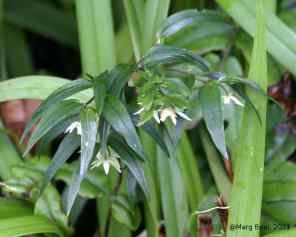 Named by Robert Brown. In the family Luzuriagaceae, formerly Liliaceae. The genus Drymophila is endemic to Australia and has only two species – D. cyanocarpa and D.moorei (which has orange-yellow berries). D. cyanocarpa is the only species of the family found in Tasmania.
Named by Robert Brown. In the family Luzuriagaceae, formerly Liliaceae. The genus Drymophila is endemic to Australia and has only two species – D. cyanocarpa and D.moorei (which has orange-yellow berries). D. cyanocarpa is the only species of the family found in Tasmania.
From the Greek drymos meaning wood or forest, and philos, loving; refers to the habitat of moist, shady forests. Cyanocarpa meaning blue fruit, common name is Turquoise Berry, or Native Solomon’s Seal.
A small, perennial herb; leaves observed between 2 – 7 cm long, lanceolate, almost sessile, twisted at the base where they hook onto the stem; flowers about 1 cm diameter, white, borne on pedicels; fruit blue/purple berry globular, about 1cm in diameter. The stems are usually branchless, and arching, with the leaves and flowers forming only on the upper part.
Here is a close-up photo I took on a recent holiday at Cradle Mountain. The image shows the way the leaf base twists where it attaches to the stem. The ridged stem is also interesting in that it zig-zags between leaf nodes. This delicate plant is often hard to spot. It only grows to about 30 cms high and you need to look carefully amongst ferns and foliage but its characteristic arching shape with suspended leaves and flowers or blue fruit is unmistakable.
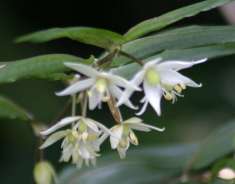 In December 2011 on Maatsuyker Island, I saw many plants flowering along the track to the Red Shed, the Gulch track and the Summit track. They occur in moist shady areas and nearly always in the company of ferns. The dainty small white flowers are axillary and hang from under the stems and leaves, reminding me of Japanese lanterns.
In December 2011 on Maatsuyker Island, I saw many plants flowering along the track to the Red Shed, the Gulch track and the Summit track. They occur in moist shady areas and nearly always in the company of ferns. The dainty small white flowers are axillary and hang from under the stems and leaves, reminding me of Japanese lanterns.
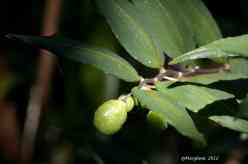 In January on the island, there were not many flowers to be found, but plenty of pale green fruit forming. During February, most the fruit had developed into purple berries but some had small circular holes and the seed had been eaten.
In January on the island, there were not many flowers to be found, but plenty of pale green fruit forming. During February, most the fruit had developed into purple berries but some had small circular holes and the seed had been eaten. 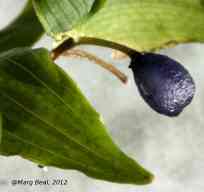 The berries can contain between eight and twenty seeds. This photo with the purple berry also clearly shows the parallel venation on the leaves, a characteristic of monocots.
The berries can contain between eight and twenty seeds. This photo with the purple berry also clearly shows the parallel venation on the leaves, a characteristic of monocots.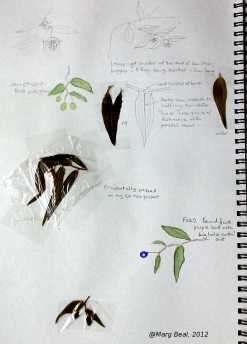
This is my Maatsuyker Island notebook page with sketches, measurements, pressings and colours. This is not a plant known to me at home in the Blue Mountains of N.S.W., but since discovering it on Maatsuyker Island I have seen it often when walking in Tasmania, both at Cradle Mountain and also in March 2015 at Melaleuca on the south west coast of Tasmania. The “Atlas of Living Australia” records it as growing in Tasmania, Victoria and southern N.S.W.
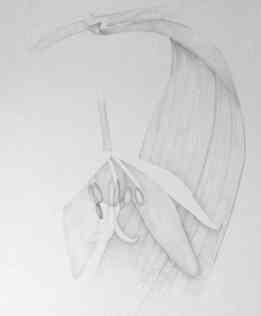 And here is a photo of my WIP “macro” drawing of the Drymophila cyanocarpa flower. The perianth (flower pieces) have six white lanceolate tepals (sometimes referred to as petals), six stamens with oblong anthers (the male bit) and three slightly flattened, thin, recurved (bending outwards) styles (the female bit).
And here is a photo of my WIP “macro” drawing of the Drymophila cyanocarpa flower. The perianth (flower pieces) have six white lanceolate tepals (sometimes referred to as petals), six stamens with oblong anthers (the male bit) and three slightly flattened, thin, recurved (bending outwards) styles (the female bit).

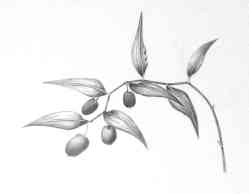
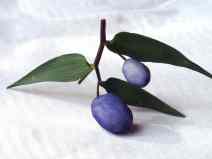
I remember this plant from Maat. Though it was low growing, the brilliant blue fruits stood out. The strident colour made me wonder if they were poisonous. Thanks for the informative post, Marg, the beautiful photos and illustrations. I love knowing what the latin names translate to as well. Bravo!
Hi Robyn, thanks for your kind words, -and- the interesting thought about the berries. I looked up a few reference books without finding the answer, however, WILDSEED TASMANIA (who sell D. cyanocarpa seeds) has a Bush Foods page and it is -not- listed there http://www.wildseedtasmania.com.au/bush_food.php so I think you may be correct! Marg x
Pingback: My Maatsuyker Island Plant List | MaatsuykerDreaming
Pingback: My Maatsuyker Island Plant List | MaatsuykerDreaming